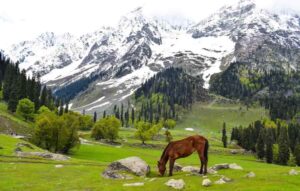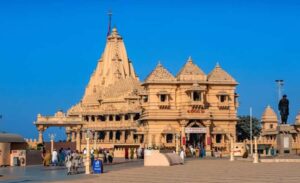Ajanta Ellora Caves Essential Travel Guide
Nestled in the heart of Maharashtra, India, lie two extraordinary UNESCO World Heritage Sites that showcase the rich cultural heritage and architectural marvels of ancient India: the Ajanta and Ellora Caves. These caves, carved into the rocky cliffs, stand as a testament to the artistic brilliance and spiritual fervor of their creators. Embarking on a journey to explore these caves promises an unforgettable experience filled with history, art, and spirituality. In this comprehensive guide, we delve into everything you need to know before you embark on your trip to Ajanta and Ellora Caves.

History
The Ajanta and Ellora Caves, located near Aurangabad in the Indian state of Maharashtra, stand as timeless witnesses to the rich cultural and artistic heritage of ancient India. These rock-cut cave complexes have captivated visitors for centuries with their exquisite architecture, stunning sculptures, and breathtaking paintings.
Ajanta Caves
The Ajanta Caves, dating back to the 2nd century BCE to 650 CE, are a testament to the golden age of Buddhist art and architecture. Carved into a horseshoe-shaped rock gorge, the Ajanta Caves comprise 30 caves that served as monastic retreats for Buddhist monks. These caves are adorned with intricate sculptures and vibrant paintings depicting scenes from the life of Buddha, Jataka tales, and various celestial beings.
Ellora Caves
In contrast, the Ellora Caves, constructed between the 5th and 10th centuries CE, showcase a harmonious blend of Buddhist, Hindu, and Jain religious traditions. Spread across a distance of 2 kilometers, the Ellora Caves consist of 34 caves carved out of solid rock. These caves include monasteries, temples, and viharas dedicated to different deities, making Ellora a unique pilgrimage site for followers of multiple faiths.
Rediscovery and UNESCO World Heritage Site
The Ajanta Caves were lost to the world for centuries until their rediscovery in 1819 by British officer John Smith during a hunting expedition. Ellora, however, remained a site of religious pilgrimage and cultural significance throughout history. In 1983, both the Ajanta and Ellora Caves were collectively designated as UNESCO World Heritage Sites, recognizing their universal value as masterpieces of human creativity.
Best Time To Visit
The Ajanta and Ellora Caves can be visited throughout the year, but the best time to explore these ancient marvels is from June to March. During this period, the weather remains pleasant, with cool mornings and evenings, making it ideal for outdoor exploration. The monsoon season from June to September adds a magical touch to the surroundings, with lush greenery and occasional showers enhancing the beauty of the caves. However, it’s advisable to avoid visiting during the scorching summer months from March to May when temperatures soar, making sightseeing uncomfortable.
Timings And Fee
Both the Ajanta and Ellora Caves have specific timings and entry fees:
- Ajanta Caves: Open from 9 am to 9:30 pm, closed on Mondays. The entry fee is INR 40 for Indian nationals and INR 600 for foreign tourists. Additional charges apply for cameras, and children below 15 years of age enter for free.
- Ellora Caves: Open from sunrise to sunset. Similar entry fees apply as for Ajanta Caves.
Difference Between Ajanta And Ellora Caves
While both the Ajanta and Ellora Caves are renowned for their architectural splendor and historical significance, there are several key differences between them:
- Distance: Ajanta and Ellora Caves are located approximately 100 kilometers apart, with Ajanta situated 104 kilometers from Aurangabad and Ellora just 29 kilometers away.
- Construction Period: Ajanta Caves were built between the 2nd century BCE and 650 CE, while Ellora Caves were constructed between the 5th and 10th centuries CE.
- Religious Affiliation: Ajanta Caves primarily served as Buddhist monastic retreats, featuring intricate sculptures and paintings depicting Buddhist themes. In contrast, Ellora Caves include Buddhist, Hindu, and Jain religious structures, reflecting the religious harmony prevalent during that period.
- Architectural Style: Ajanta Caves are carved into a horseshoe-shaped rock gorge, with each cave connected to the central courtyard. Ellora Caves, on the other hand, are scattered across a hillside, with distinct monolithic structures representing different religious traditions.
Attractions
Both the Ajanta and Ellora Caves boast a myriad of architectural wonders and artistic treasures that captivate visitors from around the world. Some of the must-visit attractions include:
Ajanta Caves

- Cave 1 (Vihara): This cave features exquisite sculptures and paintings depicting scenes from the life of Buddha, including his enlightenment and preaching.
- Cave 2 (Vihara): Known for its elaborate ceiling designs and intricate carvings, Cave 2 is a marvel of ancient craftsmanship.
- Cave 4 (Monastery): Despite being unfinished, Cave 4 is renowned for its colossal dimensions and grand architectural design.
Ellora Caves

- Cave 16 (Kailasa Temple): One of the most impressive structures at Ellora, the Kailasa Temple is dedicated to Lord Shiva and features intricate carvings and sculptures.
- Cave 10 (Vishwakarma Cave): This cave showcases the finest examples of Hindu architecture, with elaborate carvings depicting various gods and goddesses.
- Cave 32 (Indra Sabha): Known for its exquisite sculptures and frescoes, Cave 32 is dedicated to the Hindu god Indra and is a must-visit for art enthusiasts.
Things To Do
In addition to exploring the architectural wonders of the Ajanta and Ellora Caves, visitors can indulge in a variety of activities to enhance their experience:
- Attend Cultural Festivals: Experience the vibrant culture of Maharashtra by attending the annual Ajanta Ellora Festival, featuring traditional music, dance performances, and art exhibitions.
- Explore Local Markets: Discover exquisite handicrafts, paintings, and souvenirs at the bustling markets near the caves, perfect for shopping enthusiasts.
- Enjoy Nature Trails: Embark on scenic nature trails around the caves, offering breathtaking views of the surrounding landscape and wildlife.
- Participate in Guided Tours: Enhance your understanding of the caves’ history and significance by joining guided tours led by experienced local guides.
- Photography: Capture the timeless beauty of the Ajanta and Ellora Caves through photography, with ample opportunities to capture stunning landscapes and architectural details.
Interesting Facts
- The Ajanta Caves were excavated by Buddhist monks using simple tools such as hammers and chisels, reflecting their dedication to craftsmanship and devotion.
- The Ellora Caves were carved out of solid rock using only handheld tools, showcasing the remarkable skill and ingenuity of ancient artisans.
- The Ajanta and Ellora Caves served as centers of religious worship, meditation, and learning for centuries, attracting pilgrims and scholars from far and wide.
- The intricate sculptures and paintings found within the caves depict various mythological themes, religious narratives, and celestial beings, offering a glimpse into ancient Indian culture and spirituality.
- The Ajanta and Ellora Caves have inspired artists, historians, and travelers for centuries, earning them a rightful place as UNESCO World Heritage Sites and symbols of India’s rich cultural heritage.
How To Reach
The Ajanta and Ellora Caves are easily accessible from major cities and towns in Maharashtra, including Aurangabad, Mumbai, and Pune. Here are some common transportation options:
By Air
The nearest airport to the Ajanta and Ellora Caves is Aurangabad Airport, located approximately 100 kilometers away. The airport is well-connected to major cities in India, including Mumbai, Delhi, and Bangalore.
By Train
Aurangabad Railway Station is the nearest railway station to the Ajanta and Ellora Caves, located approximately 30 kilometers away. The station is served by regular trains from cities like Mumbai, Pune, and Hyderabad.
By Road
The caves are accessible by road from Aurangabad, which is well-connected to major cities and towns in Maharashtra. Visitors can hire taxis, private cars, or take state-run buses to reach the caves from Aurangabad.
Transportation
Once at the Ajanta and Ellora Caves, visitors can explore the site on foot or hire local taxis or auto-rickshaws for transportation between different caves and attractions. Guided tours and shuttle services are also available for those who prefer a more structured itinerary.
Accommodation
There are several accommodation options available near the Ajanta and Ellora Caves, ranging from budget guesthouses to luxury resorts. Some popular choices include:
- Ajanta Tourist Resort: Located near the Ajanta Caves, this resort offers comfortable rooms, modern amenities, and stunning views of the surrounding countryside.
- Hotel Kailas: Situated close to the Ellora Caves, this hotel provides spacious rooms, excellent dining options, and easy access to nearby attractions.
- Ajanta T Junction Guest House: This budget-friendly guesthouse offers clean and cozy accommodations, perfect for travelers on a tight budget.
Travel Tips
- Plan Ahead: Research the caves’ history, timings, and fees before your visit to make the most of your trip.
- Wear Comfortable Clothing: Dress comfortably and wear sturdy shoes suitable for walking and exploring the caves.
- Stay Hydrated: Carry plenty of water and stay hydrated, especially during the hot summer months.
- Respect the Heritage: Follow the rules and regulations of the caves, refrain from touching or defacing the sculptures and paintings, and help preserve these ancient treasures for future generations.
- Be Mindful of Safety: Be cautious while exploring the caves, especially in dimly lit areas, and avoid risky activities to ensure a safe and enjoyable experience.
FAQs
Q-1: Is it safe to travel to Ajanta and Ellora Caves during COVID times?
Ans: Follow government guidelines and safety protocols, including wearing masks, practicing social distancing, and sanitizing hands regularly.
Q-2: Who built the Ajanta and Ellora Caves?
Ans: The caves were constructed by skilled artisans and craftsmen over several centuries, under the patronage of various ruling dynasties.
Q-3: Can the Ajanta and Ellora Caves be visited in one day?
Ans: While it is possible to visit both caves in a single day, it is recommended to allocate at least one day for each site to fully appreciate their beauty and significance.
Q-4: Are there any local guides available at the caves?
Ans: Yes, local guides are available at both the Ajanta and Ellora Caves to provide informative tours and insights into the history and architecture of the caves.
Q-5: What are some nearby attractions to visit along with the caves?
Ans: In addition to the Ajanta and Ellora Caves, visitors can explore other nearby attractions such as Bibi Ka Maqbara, Daulatabad Fort, and Aurangabad Caves for a comprehensive cultural experience.
In conclusion, a visit to the Ajanta and Ellora Caves promises an unforgettable journey through the annals of India’s rich cultural and artistic heritage. With their timeless beauty, magnificent architecture, and spiritual significance, these ancient cave complexes continue to inspire awe and admiration among travelers from around the world.
People Also Read:






